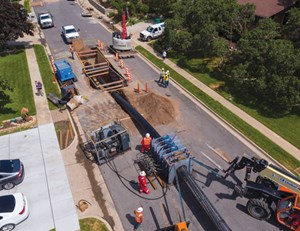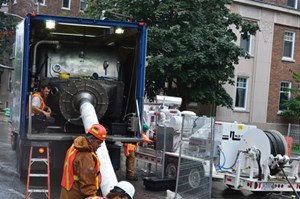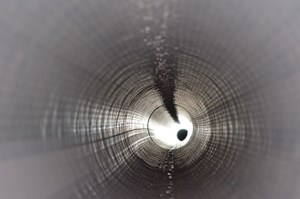October 2019 Vol. 74 No. 10
Rehab Technology
The Evolution of Rehabilitation Technology for Water Mains and Other Pressure Pipes
NASSCO’s Pressure Pipe Committee
EDITOR’S NOTE: This is the first of a three-part series on pressure pipe presented by the National Association of Sewer Service Companies (NASSCO) Pressure Pipe Committee. There will be an in-depth program track on these topics and more at UCT, Jan. 28–30, 2020, in Fort Worth, Texas.
To understand the evolution of pressure pipe rehabilitation technology, it also helps to understand the evolution of pressure pipe itself.
Logically, the first water lines were constructed in North America during the United States Colonial era, by simply boring out logs. Boston, Mass., is where the first waterworks were constructed with these materials, in 1652, to provide water for firefighting and domestic use. Wooden pipes eventually evolved into wood stave pipes and were commonly used until the early 1800s, when increased pressure was required.
The origin of iron pipe dates to 1664 when the first cast iron pipe was built for water service in Versailles, France. In 1804, Philadelphia, Penn., was the first city in North America to use cast iron watermains, importing the iron from the European Market. The first North American cast iron was made in 1843, at a foundry established in Millville, N.J.
Cast, and then ductile, iron had many key developments in North America, over time, that have had a profound impact on both rehabilitation needs and the best techniques to resolve problems, to this day. Some of these developments included:
- 1903 – Development of the first American Water Works Association (AWWA) Standard for vertical cast pit iron pipe (standardized pipe)
- 1922 – Invention of the centrifugal casting method of pipe manufacture (thinner wall pipe)
- 1937 – First rubber gaskets joint,
which started to replace leaded joints (better hydrostatic integrity) - 1939 – First AWWA Standard
for Centrifugally Cast, cast iron (widespread use of thinner wall pipe) - 1950s – Transition from lead and galvanized iron house connections
to widespread use of copper
(increased corrosion rates) - 1955 – Introduction of Centrifugally Cast, ductile iron (even thinner
walled pipe) - 1957 – First push-on joint rubber
gasket (modern-day, reliable
hydrostatic integrity at joints) - 1965 – First AWWA Standard for
Ductile Iron pipe (widespread use
of even thinner walled pipe) - 1970s – Widespread use of internal linings in CI and DI pipe in manufacturing
The first asbestos cement (AC) pipes were made in Italy in 1913, and were produced in the North American market by Johns-Manville in 1930. AC pipe experienced widespread use in North America in areas where soils were unusually corrosive to iron. When the relationship between health problems and occupational exposure to asbestos was firmly and legally established in 1973, both Canadian and U.S. pipe manufacturers began placing more emphasis on the production of thermoplastics, such as PVC pipe.
Pressure Pipe Rehab Technologies
Pressure itself typically did wood pipes in, and while there would be new rehabilitation challenges to address new materials, the evolution of the pressure pipe rehabilitation market, to date, has largely been in response to the evolution of iron pipe products over time. Specifically, evolution of products addresses the unique aspects of degradation associated with ferrous metals, cementitious materials or ferrous metal-cementitious composite pipe materials, like prestressed concrete pressure (PCP) pipe.
The first rehabilitation technique focused on water quality and hydraulic issues associated with unlined cast iron pipe. Unlined cast and ductile iron pipe remained common until the early 1970s.
Cement mortar lining (CML) was implemented in Australia in trowel-on applications as early as 1905. It gained widespread use in 1934, when it introduced as a spray-on application in New Jersey. CML remains the most common non-structural spray lining technique utilized in pressure pipe to this day.
The next generation of technologies involved the advent of spray-on polymeric systems. Spray-on epoxies were first trialed in the UK during the 1970s, where virtually tens of thousands of miles have been relined. Polymeric linings evolved further in the last couple of decades to include the use of rapid-setting polyurethanes and polyurea hybrids. As these systems evolved, it became understood that they actually added structural enhancement to the host pipe, in addition to the benefits of improved hydraulics and water quality. Rapid-setting polymers also allowed for a same-day return to service, which changed the dynamics of program implementation.
Sliplining, the oldest form of fully structural rehabilitation, started in the 1940s. The development of polyethylene pipe in the 1950s greatly enhanced the technical feasibility of sliplining and increased its use. Conventional sliplining inherently results in a large reduction in diameter. In the 1980s and throughout the 1990s this led to the development of a wide range of variations of sliplining techniques, including close-fit liners whereby the cross section of the liner is temporarily reduced, deformed or folded to accommodate insertion into the host pipe and minimize the diameter reduction seen with conventional sliplining.
Pipe bursting utilizes same path technology by fracturing, splitting or bursting the existing pipe while pulling in new pipe through the existing path. While pipe bursting provides for full structural rehabilitation, it also allows for upsizing the diameter to accommodate the need for additional capacity.
Cured-in-Place Pipe (CIPP) was first introduced for gravity sewer applications in 1971. Lower pressure applications, such as sewage force mains, were routinely relined in the 1980s and the inaugural edition of ASTM F1216 in 1989 had pressure pipe design considerations in Appendix X1.
However, it wasn’t until 1998 that a fully structural reinforced pressure pipe CIPP was developed and used to rehabilitate pressurized water service pipelines at the Perry Nuclear Plant in Cleveland, Ohio. The advent of reinforced CIPP liners greatly expanded the use of CIPP as an alternative to conventional replacement, due to its reduced construction footprint and the potential to reduce capital and life cycle cost.
Montreal’s program started in 1999, was ramped up markedly in 2008, and routinely does 35,000 to 40,000 feet annually. Since the city of Toronto started its dedicated CIPP Fully Structural Relining Program in 2008, it has grown to a $55-million annual program attempting to rehabilitate some 200,000 feet of water main annually.
Industry Standards
The rehabilitation “toolbox” has increased considerably since someone first hand-troweled cement mortar on the inside of an iron pipe in 1905. A wide range of rehabilitation needs have been identified and a wide range of solutions have been developed and continue to evolve. In North America and worldwide, the framework for matching problems to technology owes a lot to the development of a Structural Classification System for water main rehabilitation systems.
The concept of a Structural Classification System for lining technologies for pressure pipes dates back to late 1990s’ work by Drs. Jesse Boot, John Heavens and John Gumbel, in the United Kingdom. It was introduced in North America in the Second Edition of AWWA Manual M28, Rehabilitation of Water Mains, published in 2001, and in the UK under BS EN 13689: “Guidance on the classification and design of plastics piping systems used for renovation” in 2002.
The concept developed was a qualitative one, based on intended function of the lining technology, its degree of interaction with the host pipe, and the type of loads the lining was intended to resist. While the qualitative framework has served the industry well to match rehabilitation solutions to known water main problems or deterioration modes, there is a large gap between “qualitative” and “quantitative” objectives, as the industry put the classification system into actual practice.
Development of industry standards is a work in progress, with an objective of providing common language and guidelines for the assessment and use of pressure pipe rehabilitation technologies in organizations like AWWA and NASSCO. Through these standards, critical installed material properties and values are defined, along with repeatable testing for product compliance and installed acceptance.
NASSCO addresses pressure pipe rehabilitation issues through its Pressure Pipe Committee. This select group of industry professionals is responsible for researching current pressure pipe assessment and rehabilitation processes, with a goal to establish standards to assess and rehabilitate force mains and water lines.
The pressure pipe rehabilitation market is evolving and growing at a fast rate. Well over a million miles of drinking water pipe are in service in North America, with much of it operating beyond its intended design life. Nearly 6 billion gallons of treated drinking water are lost every day (or over 2 trillion gallons per year) through leaking pipes and breaks.
In order to meet demands, AWWA estimates that $1 trillion of investments in water infrastructure is needed over the next 25 years alone. Increased acceptance and utilization of viable trenchless technology solutions, research and standards in a proactive approach will help reduce break frequencies, improve water quality, save energy in the transport of water, as well as close the funding gap. •







Comments